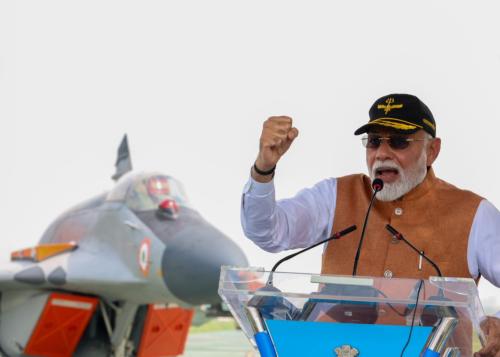Content from the Brookings Institution India Center is now archived. After seven years of an impactful partnership, as of September 11, 2020, Brookings India is now the Centre for Social and Economic Progress, an independent public policy institution based in India.
Support for this research was generously provided by the Australian government, Department of Foreign Affairs and Trade (DFAT). Brookings India recognises that the value it provides is in its absolute commitment to quality, independence, and impact. Activities supported by its donors reflect this commitment and the analysis and recommendations found in this report are solely determined by the scholar(s).
On January 26, 2018, the 68th anniversary of India becoming a republic, New Delhi hosted the leaders of all 10 member states of the Association of Southeast Asian Nations (ASEAN) – from the Philippines’ Rodrigo Duterte to Indonesia’s Joko Widodo, Myanmar’s Aung San Suu Kyi to Thailand’s Prayuth Chan-ocha. For India, Republic Day has begun to assume a diplomatic significance, featuring a foreign head of state or government as the chief guest for the commemorative festivities. Recent chief guests have reflected India’s foreign policy priorities: Japanese Prime Minister Shinzo Abe in 2014, U.S. President Barack Obama in 2015, and French President Francois Hollande in 2016. But the appearance in 2018 of not one but 10 leaders from Southeast Asia was a major demonstration of the growing importance that India accords its “Act East” Policy.
The Act East Policy remains the subject of considerable confusion both in India and overseas, for several reasons. First, it is not a doctrine spelled out in an official Indian government document, such as a white paper, although its contours are clearly discernible, including in speeches by senior officials. Second, the Act East Policy represents the rebranding of an earlier Look East Policy, which arose in the early 1990s. The differences between the two have not always been made clear. Third, the Act East Policy has often been lost amid a number of related, but distinct, strategic initiatives and concepts adopted not just by India but by other countries. There is particular confusion over India’s recent adoption of the Indo-Pacific strategic concept, its relationship with the separate “free and open Indo-Pacific” strategies of Japan and the United States, and conflation with the quadrilateral security dialogue (or “quad”) involving Australia, India, Japan, and the United States.
But in fact, the Act East Policy is rather specific about its ends, ways, and means. India’s Act East Policy evolved naturally from the Look East Policy as a direct consequence of the nature of China’s rise; the inadequacies of the regional security order in Asia; and India’s own growing capabilities, profile, and obligations. By “Acting East,” India can play a meaningful role in managing China’s rise, incentivising its evolution into a more transparent, market-driven, status quo-oriented, and norm abiding power. It can also help to shape the regional order in a manner that is advantageous to Indian interests. Act East consequently represents the securitization of India’s eastward engagement, reflects a wider scope that encompasses the Indo-Pacific region, and heralds a greater urgency. It is meant to preserve a favorable balance of power by ensuring a free, open, and inclusive Indo-Pacific. The Act East Policy has antecedents, and India can build upon its earlier history of leadership in Asia between 1947 and 1962.
Looking ahead, India’s Act East Policy will involve at least four elements. One, India will have to secure the Indian Ocean region against greater security competition through better maritime domain awareness, improved naval capabilities and presence, enhanced infrastructural and capacity development, and greater institutional leadership. This is at the core of Prime Minister Narendra Modi’s slogan for the Indian Ocean, SAGAR (“security and growth for all in the region”). Two, India will have to accelerate its diplomatic, economic, and military integration with Southeast Asia in order to preserve a stable balance of power in the region. This would complement attempts to preserve the institutional centrality of the Association of Southeast Asian Nations (ASEAN), but will also require working bilaterally with Southeast Asian countries on security, trade, and connectivity. Three, India will have to deepen its strategic partnerships with other countries that share its concerns about the manner of China’s rise, especially the United States, Japan, and Australia, but also France, Russia, and others. Fourth, India will have to manage relations with China, mitigating differences while seeking avenues for engagement whenever possible. Finally, in addition to continuing with ongoing efforts, India will need to prioritise a number of new areas, including regional trade, naval acquisition, overseas project implementation, defense exports, air connectivity, and foreign investment screening. The following paper provides an overview of historical antecedents for India’s reengagement with the region, outlines the driving factors for India’s Act East Policy, describes the conceptual evolutions of Act East and the Indo-Pacific, details the four elements of India’s Act East Policy to date, and, in conclusion, identifies priority areas for future Indian policy.
The Brookings Institution is committed to quality, independence, and impact.
We are supported by a diverse array of funders. In line with our values and policies, each Brookings publication represents the sole views of its author(s).





